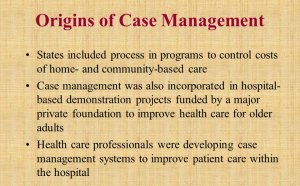
Types of Case Management
Case administration 's been around since the 19th century and has evolved into a diverse and complex set of methods found in health care, personal work, and a myriad of relevant industries. The Commission for Case Manager Certification’s definition provides an excellent starting point for knowing the number of case administration techniques and models:
“Case administration is a collaborative process that assesses, programs, executes, coordinates, screens and evaluates the choices and services expected to meet with the client’s health and human solutions needs. It Really Is described as advocacy, communication, and resource administration and promotes quality and cost-effective treatments and results.”
Various contexts necessitate various approaches to instance management. Strong situation administration techniques are carefully adapted on needs, constraints, and sources which exist within a given context. Adults with actual handicaps is best offered by one set of methods or ways to situation management while those exact same methods are unimportant and even damaging to kids with psychological state issues or teenagers dealing with drug abuse or addiction.
Building a powerful situation management approach begins by distinguishing a foundational model which can be adjusted to meet up with the requirements of your specific customers and resources. Take a look at 3 special situation administration designs which can be adapted and tailored to operate a vehicle effective outcomes in a selection of instance administration configurations.
The Brokerage Case Management Model
The brokerage design is an extremely brief approach to instance management in which case workers attempt to assist clients recognize their demands and agent supportive services within one or two connections. This model assumes that a client will voluntarily make use of needed solutions when they understand these are typically readily available, and learn to access all of them. This model works best whenever a client’s biggest challenge is usage of services, in place of option of services.
In a brokerage case administration design, the case manager/social worker provides almost no direct service towards client. As an alternative, they act as a connection between a customer and community resources. The focus is on assessing requirements, planning a site strategy, and connecting consumers.
A brokerage design may put less increased exposure of tracking and measuring outcomes. The corporation offering instance management services in a brokerage instance supervisor design, however, might be able to coordinate data collection and evaluation across companies. Among the best techniques to do that would be to encourage and recommend when it comes to usage of a built-in instance management system. When companies and situation managers utilize incorporated methods for evaluating requirements, tracking services, and measuring outcomes, they can easily capture important information about their particular coordinated efforts.
The Clinical Case Management Model
In a clinical case administration model, a clinical attention supplier serves as the way it is supervisor. Regularly, the case manager is a counselor or therapist. This model understands that numerous clients face obstacles to solutions that reach beyond quick concerns of access.
As a clinician, the way it is manager in a medical situation administration model provides direct counseling for a client’s individual concerns. That might feature psychological state solutions, addiction data recovery assistance, or treatment for serious or chronic health problems. If the situation manager normally providing clinical services, they may have unique understanding of the client’s needs. That enhanced degree of understanding gets better the outcome manager’s capability to recognize required solutions and connect the client with formal resources in the shape of neighborhood providers.
Possibly more notably, clinical care providers have actually a higher capability to encourage the client to connect with informal sources such as for instance household, pals, and colleagues. That collaboration can increase the client’s determination and power to follow through with services.
The medical instance supervisor normally well-positioned to assist the customer target social, emotional, and psychological barriers to solutions. It’s not surprising that a clinical situation management model can cause more productive outcomes for clients that less inclined to engage voluntarily with services. The design is also especially ideal for customers who need assistance over a long time period.
The Strengths-Based Clinical Case Management Model
The strengths-based clinical instance management model recognizes that the best goal of a case supervisor goes beyond only accessing services. In a strengths-based clinical situation administration design, case supervisors consider empowering consumers and their families. Case management and clinical services concentrate on creating client options for growth, training, and ability development.
Like a clinical case administration design, the strengths-based instance management model acknowledges the worth of community solutions, household, and cross-agency partnerships. It promotes the customer to create and nurture informal assistance communities alongside identifying and opening formal neighborhood solutions and institutional sources. However, the strengths-based case management model steps out of the viewpoint that the clinician could be the expert in the client’s requires. It encourages the customer to take the lead in pinpointing their own requirements, take control throughout the find resources and solutions to handle those needs, and view the community as a resource instead of a barrier to success as an alternative.
Strengths-based medical situation management designs include outreach, clinical solutions, advocacy, and sturdy control between instance managers and consumers. Implementing a program centered on this design needs that companies and companies support instance supervisors with a robust instance administration system that may monitor extremely individualized services and capture complex information and metrics.
Summary
Besides understanding the differences between situation management models, its also wise to comprehend the resources and infrastructure needed seriously to support situation managers. Which case administration design your organization uses will more than likely affect your database together with effects you monitor.
Personal possibilities’ ETO and Apricot computer software support the efforts of companies utilizing a variety of instance administration models. ETO and Apricot monitor a client’s progress through programs so situation supervisors can see what’s working really and just what requires enhancement. These insights tend to be critical when optimizing a course for results. ETO and Apricot save frontline staff time, make reporting easy, and area essential insight on customer progress. All of this eventually permits instance managers to own more effect on their customers. to see which Social possibilities product might help your company achieve much more goal.
Share this Post
Related posts
Definition of Case Management in Healthcare
You realize, basically hear that maybe a particular case supervisor is on this case and I occur to work well with this person…
Read MoreDefinition of Case Management
The truth control process may be the way situation administration functions (for example. phases) tend to be performed because…
Read More
















